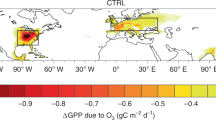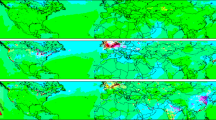Abstract
OZONE is the principal constituent of the photochemical smog that plagues many cities in the United States. Produced by the action of sunlight on the hydrocarbons and oxides of nitrogen emitted by vehicles and industry, concentrations of ozone greater than 25×1011 molecules cm−3 (1×1011 molecules cm−3 =0.4 parts per hundred million = 8 µg m−3), used as evidence of photochemical smog1, have been observed in Los Angeles for more than two decades2. Because of lower air temperatures, less sunshine and fewer vehicles, photochemical pollution was considered unlikely to occur in Western Europe but concentrations indicative of photochemical smog have now been reported from Germany3, the Netherlands4,5 and southern England6,7 on calm, sunny days. High concentrations of ozone cause respiratory difficulties in humans8 and damage many plants9 including crops10.
This is a preview of subscription content, access via your institution
Access options
Subscribe to this journal
Receive 51 print issues and online access
$199.00 per year
only $3.90 per issue
Buy this article
- Purchase on Springer Link
- Instant access to full article PDF
Prices may be subject to local taxes which are calculated during checkout
Similar content being viewed by others
References
Air Quality Criteria for Photochemical Oxidants, chapter 3 (US Department of Health, Education and Welfare, Washington, 1970).
Haagen-Smit, A. J., Ind. engng Chem., 44, 1342 (1952).
Jost, D., Pure appl Chem., 24, 643 (1970).
Wisse, J. A., and Velds, C. A., Atmos. Environ., 4, 79 (1970).
Wisse, J. A., and Velds, C. A., Atmos, Environ., 4, 187 (1971).
Atkins, D. H. F., Cox, R. A., and Eggleton, A. E. J., Nature, 235, 372 (1972).
Derwent, R. G., and Stewart, H. N. M., Nature, 241, 342 (1973).
Palm, P. E., and Nick, M. S., in Environmental Biology (edit. by Altman. P. L., and Dittwer, D. S.), 281 (Fedn Am. Soc. exp. Biol. Bethesda, Md. 1966).
Rich, S., A. Rev. Phytopath., 2, 253 (1964).
Heggestad, H. E., and Heck, W. W., Adv. Agron., 23, 111 (1971).
Regener, V. H., J. geophys. Res., 62, 221 (1957).
Aldaz, L., J. geophys. Res., 74, 6943 (1969).
Galbally, I., Q. Jl. R. Met. Soc., 97, 18 (1971).
Turner, N. C., Rich, S., and Waggoner, P. E., J. environ. Quality, 2, 259 (1973).
Rich, S., Waggoner, P. E., and Tomlinson, H., Science, 169, (1970).
Hill, A. C., J. Air Pollut. Control Ass., 21, 341 (1971).
Thorne, L., and Hanson, G. P., Environ. Pollut., 3, 303 (1972).
Waggoner, P. E., BioScience, 21, 455 (1971).
Waggoner, P. E., and Reifsnyder, W. E., J. appl. Met., 7, 400 (1968).
Waggoner, P. E., Furnival, G. M., and Reifsnyder, W. E., Forest Sci., 15, 37 (1969).
Waggoner, P. E., in Physiological Aspects of Crop Yield, (edit. by Eastin, J. D., Haskins, F. A., Sullivan, C. Y., and Van Bavel, C. H. M.), 343 (American Society of Agronomy, Madison, Wis., 1969).
Turner, N. C., and Parlange, J. Y., Pl. Physiol., 46, 175 (1970).
Waggoner, P. E., Begg, J. E., and Turner, N. C., Agric. Met. 6, 227 (1969).
Waggoner, P. E., and Turner, N. C., Agric. Met., 10, 113 (1972).
Engle, R. L., and Gabelman, W. H., Proc. A. Soc. hort. Sci., 39, 423 (1966).
Rich, S., and Turner, N. C., J. Air Pollut. Control Ass., 22, 718 (1972).
Turner, N. C., and Begg, J. E., Pl. Physiol., 51, 31 (1973).
Inman, R. E., Ingersoll, R. B., and Levy, E. A., Science, 172, 1229 (1971).
Garland, J. A., Clough, W. S., and Fowler, D., Nature, 242, 256 (1973).
Crutzen, P., Pure appl. Geophys., 106–108, 1385 (1973).
Leuy, H., Planet. Space Sci., 21, 575 (1973).
Author information
Authors and Affiliations
Rights and permissions
About this article
Cite this article
TURNER, N., WAGGONER, P. & RICH, S. Removal of ozone from the atmosphere by soil and vegetation. Nature 250, 486–489 (1974). https://doi.org/10.1038/250486a0
Received:
Revised:
Issue Date:
DOI: https://doi.org/10.1038/250486a0
This article is cited by
-
Physiological, biochemical, and molecular responses of rice (Oryza sativa L.) towards elevated ozone tolerance
Cereal Research Communications (2023)
-
Shifts in microbial communities in soil, rhizosphere and roots of two major crop systems under elevated CO2 and O3
Scientific Reports (2017)
-
Elevated ground-level O3 negatively influences paddy methanogenic archaeal community
Scientific Reports (2013)
-
Elevated Ground-Level O3 Changes the Diversity of Anoxygenic Purple Phototrophic Bacteria in Paddy Field
Microbial Ecology (2011)
-
Analysis of vertical ozone and nitrogen oxides profiles in aPrunus cerasifera canopy
International Journal of Biometeorology (1995)
Comments
By submitting a comment you agree to abide by our Terms and Community Guidelines. If you find something abusive or that does not comply with our terms or guidelines please flag it as inappropriate.



